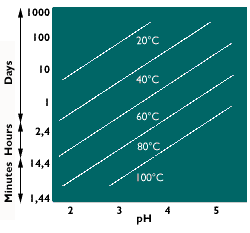In acidic products, especially those with pH under 4 (jam, fruit purťe and many soft drinks) more than half of the sucrose added is inverted to glucose and fructose when the products are consumed
| |||||||||||||||

| Summary |
|
Dissolve 5 kg of sugar & 60g of nutrients in 20L of water, and
cool to below 30C before adding hydrated yeast. Different sugars will result in sweeter or drier alcohols. |
| Hours | SG |
| 0 | 1.110 |
| 12 | 1.105 |
| 24 | 1.070 |
| 36 | 1.040 |
| 48 | 1.004 |
| 60 | 0.997 |
| 72 | 0.990 |
In acidic products, especially those with pH under 4 (jam, fruit purťe and many soft drinks) more than half of the sucrose added is inverted to glucose and fructose when the products are consumed
| |||||||||||||||

| http://homedistiller.org This page last modified |